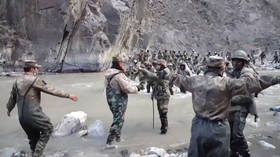India objects as China renames places near disputed border
Beijing has issued a new list of renamed locations in Arunachal Pradesh, considered by New Delhi to be an “integral part” of India
India on Tuesday reacted sharply to China’s ‘renaming’ of locations in Arunachal Pradesh, a remote region claimed by both countries and located along the 3,488-kilometer Line of Actual Control that separates the two neighbors.
China’s Ministry of Civil Affairs on Saturday released 30 new names in the disputed border region, which it calls Zangnan and considers a part of Tibet Autonomous Region, Chinese outlet Global Times reported. The renaming covered 11 residential areas, 12 mountains, four rivers, a lake, a mountain pass and a piece of land, with 30 new names in all given in Tibetan and pinyin, the Roman alphabet version of Mandarin Chinese.
Beijing previously released the first list of “standardised names” of six places in the disputed territory in 2017, a second list of 15 places in 2021, followed last year by another list, this one renaming 11 places.
“China has persisted with its senseless attempts to rename places in the Indian state of Arunachal Pradesh. We firmly reject such attempts,” India’s foreign ministry’s spokesperson said in a statement on Tuesday. On Monday Minister of External Affairs Subrahmanyam Jaishankar termed China’s renaming of the locations “senseless.” He said New Delhi firmly rejected such attempts and sees Arunachal Pradesh as an “integral and inalienable part of India.”
India’s reaction this time was similar to its stance last year when Beijing released a new ‘standard map’ that showed Zangnan and the Aksai Chin plateau as parts of China. New Delhi rejected the map and lodged a “strong protest” against China “through diplomatic channels.”
The latest confrontation comes amid strained ties between the two nuclear-powered Asian giants. Beijing last month criticized a visit by Indian Prime Minister Narendra Modi to Zangnan/Arunachal Pradesh to inaugurate a tunnel, which could hasten a deployment of Indian troops to the countries’ agreed frontier. New Delhi hit back, stating that “repeating baseless arguments […] does not lend such claims any validity.”
Nonetheless, the two nations held a fresh round of border talks last week. The discussions yielded no major breakthroughs despite both countries expressing a commitment to achieving complete disengagement and resolving the remaining issues. Tensions at the India-China border escalated in 2020 after a clash in the Galwan Valley caused fatalities on both sides. The Indian Army has since maintained a high level of combat readiness while the government ramped up infrastructure development in the high-altitude region, matching upgrades implemented by China.
Meanwhile, Washington has recently waded into the controversy when it recognized Arunachal Pradesh as part of India and “strongly opposed” China’s “unilateral attempts to advance territorial claims.” The Chinese Foreign Ministry “strongly deplored” and “firmly opposed” the US comments. A Global Times editorial earlier this month claimed that US’ move seems to be helping India “on the surface,” but that, in reality”it is handing India a tempting poison.”
Where India Meets Russia – We are now on WhatsApp! Follow and share RT India in English and in Hindi
You can share this story on social media:








Comments are closed.